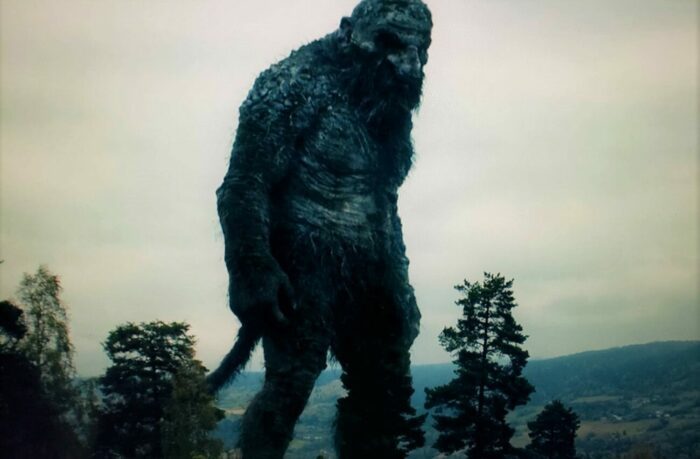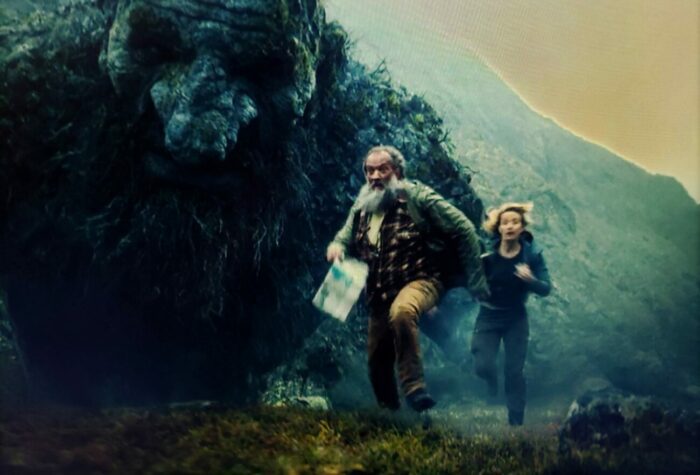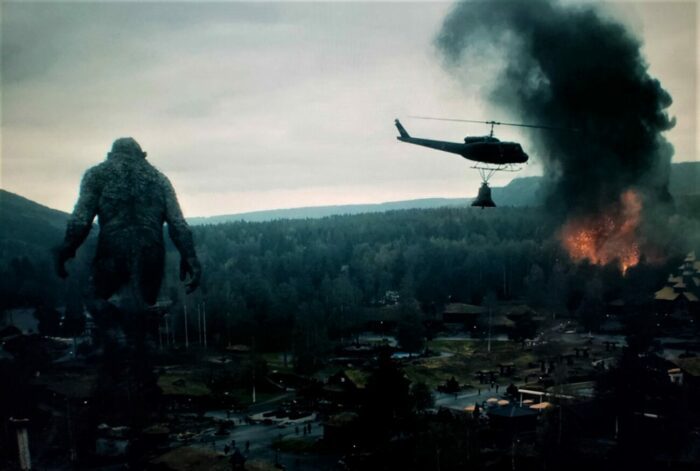Horror often benefits from its metaphorical potential, and Troll, recently released on Netflix, is no exception. Consider how vampires have long been associated with numerous symbolic concepts. Everything from sexually transmitted disease, to xenophobia, and addiction. Zombies have been used to effectively criticize mindless consumerism. Even Godzilla, easily the most famous kaiju, is long understood to be a metaphor for the horrors of nuclear weapons. Like its strange beast predecessor, Troll is not without its subtext. And while the titular monster’s symbolism may occasionally be as subtle as getting stepped on by the behemoth, the context for it might not be so obvious.
For those unfamiliar, Troll follows a team racing to save Norway from a recently resurrected troll. The colossal creature slumbered beneath a mountain until a tunneling crew disturbed it. Awakened after centuries, the titanic being emerges and wreaks havoc. However, the race soon shifts from stopping the troll to understanding it as the team realizes this entity is more than living folklore. In fact, its existence upends notions instilled by myth and legend.

Troll echoes sentiments found in films like 2010’s Monsters. The central notion is that the dangerous entities in creature features may not be malevolent. They may simply be doing what comes naturally, but humans have misconstrued these actions as intentionally evil. Sharks are a great example of this insofar as no great white attack has been the result of Carcharodon carcharias thinking, “Today I’m gonna eat some people.” Troll also calls to mind John Gardener’s 1971 novel ‘Grendel’ which retells the classic ‘Beowulf’ from the monster’s perspective.
The point being, this movie combines those narrative conceits; humanity at odds with nature, and the point of view of the so-called villain. Troll conveys the notion that the titular creature is not unlike a bear awakening from hibernation to find a subdivision sprouted around its cave. Humans panic at the sight, while anything the bear does isn’t malevolent but a combination of confusion and natural instinct. It makes the monster sympathetic, especially as the story gets into some anti-Christian territory.
Part of the purpose of Gardner’s ‘Grendel’ is looking at how literature reshapes the understanding of events. The past is particularly subject to revision due to narrative histories. This is exampled in the movie Troll as the main characters start to realize the prevailing folklore is meant to vilify these entities.

For example, there is the notion of trolls being averse to the sound of church bells. The stories imply this is due to trolls being evil creatures. The pain they experience is unholy ears stung by the melodious ringing of sanctified bells. However, the truth, according to this film, seems to be simpler: trolls just have sensitive ears. Enraged by the pain caused by ringing bells, they demolished churches to end their agony.
Oddly enough, this mirrors the history of Christianization in Norway. On the one hand, Scandinavian countries like Denmark, Sweden, and Norway made a relatively smooth transition to Christianity. Still, bumps in the road led to animosity, which persists to this day.
Historically, Norway was the most difficult to transform from polytheism to Christianity out of the Scandinavian countries, due to rules controlling religious leanings. The short version is that Vikings brought Christianity to the Scandinavian region. In Norway, King Haakon tried to peacefully spread the religion with some success. When he died, rulers inclined towards paganism took reign and erased the Christian presence from the country. This inspired King Olaf Tryggvason to bring back Christianity by any means necessary. The bloody subjugation and erasure of paganism which followed then tragically ripples across time.
During the 1990s, the rise of black metal in Norway resulted in over 50 church burnings. As explored in the 2008 documentary Until the Light Takes Us, this transgressive subculture saw Christianity as an influence that robbed Norwegians of their culture. In other words, they perceive the religion as an outside influence which vilified their cultural heritage.

Now, it’s worth noting that many Norwegians don’t share the bitterness of this sentiment. Still, although the majority of the population identifies as Christian, the country’s population has been steadily participating in the church less and less. This hasn’t been so much a rejection of the faith as a reevaluation of its role in people’s lives, which in turn shifts the way it’s perceived as well as represented. For instance, historians like Professor Helje Kringlebotn Sødal have endeavored to show the influence of ordinary people rather than glorify church hierarchy.
There’s an implication of power through fictional representation. Christianity has long been the saving grace in several stories. Vampires shrink from the cross, but no other religious icon seems to have the same effect. It’s implicative, and more so, suggestive of avenues unexplored. Consider, the majority of possession films feature a priest coming to the rescue, and while people may be inclined to suggest other faiths don’t have a history of exorcisms, that’s more cultural ignorance than fact. Muslim possession stories typically involve jinn, but getting rid of them is similar to what’s seen in things like The Exorcist, specifically recitations from the Quran, particularly al-Baqara 255.
This is all to say a Western-centric point of view repeatedly represents Christianity in a favorable light even regarding other Western cultures. Whatever history existed prior to Christendom is presented as evil, employing a fallacious syllogism wherein Christianity is good, evil is repelled by the religion, and anything repelled by anything Christian is evil.

Troll, however, has the refreshing nerve to question this dubious logic. The beast is essentially a living representation of the past paganism that dominated the land. Instead of showing a religion saving the country from the monster, the movie shows how a misunderstood creature is bitter about its mistreatment. In a way, Christianity isn’t the hero but isn’t the villain either. It’s more like someone who took a shark attack personally.
This isn’t to say director Roar Uthaug or writer Espen Aukan put this project together with all this in mind. I even took the time to peruse their accessible social media (i.e. Twitter) to see if they posted anything to imply such a metaphorical mindset. Finding nothing almost makes this proposal easier to write off. I’ll admit, I’m a crack a beer and watch a flick kind of fellow. So, the idea this many layers, context, and historical influence are found in a feature film about a giant bearded guy stepping on things—it feels a bit much. Borderline pretentious, even. However, once aware of these things, it’s hard not to see them in the film.
That isn’t to say symbolism is the best part of a horror story. The subtext it offers simply provides another layer. Granted, the message may be entirely missed without sacrificing quality. Audiences don’t need to appreciate the werewolf as a metaphor for puberty and feminism in order to enjoy the thrill of Ginger Snaps. But it is there for those willing to see it.
None of which makes Troll necessarily deeper or more brilliant. It merely adds a facet. One that may be more engaging than mindless destruction. Still, more importantly, the cultural history reveals, perhaps, why filmmakers employed such a point of view.



